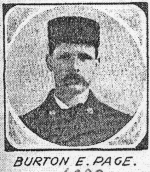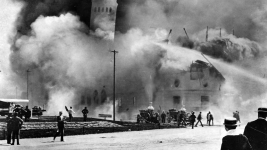Fire Service Line of Duty Deaths
July 10, 1893 Chicago’s Cold Storage Fire – The White City Fire. 13 LODDs.
On July 10, 1893 thirteen Chicago Firefighters died in the line of duty while fighting the White City Fire of 1893 at the Chicago World’s Fair.
• Captain James Fitzpatrick
• Captain James Garvey
• Captain Burton Page
• Lieutenant Charles Purves
• Truckman Phillip Breen
• Truckman John Cahill
• Pipeman William Denning
• Lieutenant John Freeman
• Driver John McBride
• Driver M. McQuade
• Truckman Paul Schroeder
• Driver John Smith
• Pipeman Louis Frank
The fire occurred in the Cold Storage Building. This building was a technological marvel of 1893 World’s Fair in Chicago, making ice, keeping meat cold and boasting an indoor ice skating rink. Like many buildings at the Fair, the Cold Storage building was erected quickly with little concern for safety. On July 10th, fire erupted in the building killing 17 people in total in front of a crowd of tens of thousands of onlookers.
The building was five stories high, designed by architect Franklin P. Burnham in the style of a Moorish palace, with a statue of Christopher Columbus holding a globe at the main entrance. The main building was 255 by 130 ft with plain white walls broken only by windows on the top floor, which was equipped as a skating rink. The towers on each corner of the building rose to 115 ft, with the central tower, which housed the boiler flue, rising a total of 191 ft above street level. The store roof was about 60 ft above street level, and the gallery around the central tower was at a height of about 120 ft. Access to the gallery was provided by a staircase from the top floor, but there was no means of ascent from there to the top of the chimney stack. The construction of the boiler flue had already attracted a great deal of criticism and had caused a few minor fires in June, resulting in the cancellation of most of the insurance policies on the building.
The alarm sounded at 1:30 p.m. when a small fire at the top of the flue stack was spotted. The responders came from the World’s Fair fire service and the local fire station, which was only a few blocks away. As on previous occasions, about 12 firemen climbed onto the roof of the cold store and climbed the staircase from the ice rink on the fifth floor to the gallery of the central tower. From there they nailed boards to the walls to create footholds and climbed up to the narrow ledge that formed the roof of the gallery. However, shortly after reaching the ledge above the gallery, just below the summit of the tower, there was a sudden outburst of flame below them, preceded by a small puff of white smoke. The fire at roof level spread very rapidly and cut off the escape route for the fireman up the tower. A few were able to slide down the ropes used to drag the hoses up, but the ropes and hoses were quickly burned through, and the rest of the group were left with no means of escape. One by one they jumped the 60 ft from the gallery to the main roof, but all were killed or seriously injured by the fall.
The tragedy at the cold storage building of the Chicago World’s Fair on July 10, 1893, was caused by a combination of human error in designing the building, in executing its construction and commissioning, and in responding to the initial fire alarm. The fire would destroy this building, the nearby horse stables and then then jump Stony Island Avenue and burn a couple of other structures before burning itself out.
In 1893, Chicago hosted the World’s Columbian Exposition, a fair celebrating the 400th anniversary of Columbus’s voyage to North America. The $30 million fair, constructed along Lake Michigan in what is now Jackson Park, included 200 buildings, exhibitors from more than 60 countries, and the world’s first ferris wheel. To glamorize the fairgrounds, building exteriors were covered with white plaster so that each building looked like it was carved out of marble. This idea, that no buildings in the “White City” appear unsightly, later caused a tragic fire that killed fourteen firefighters and three civilians.
The Cold Storage Building was one of the largest buildings at the fair. Built by Hercules Iron Works and the Ice and Refrigeration Machine Manufacturers, the warehouse housed perishable food used by the various fair vendors and also doubled as an ice skating rink. The six-story building required a 200-foot iron chimney to run the refrigeration units, but designers believed that the smokestack would clash with the fair’s other buildings. To remedy this, a wooden tower topped with a decorative cupola was built around the chimney. The base of this cupola was only 30 inches above the chimney’s upper rim, creating a serious fire hazard. In fact, on June 17, 1893, there was a small fire in the cupola, but it was quickly doused. Fair management never learned of the blaze, but the acting chief of the World’s Fair Fire Department stated, “That building…is a miserable firetrap and will go up in smoke before long.”
Shortly after 1 PM on July 10, heavy smoke was spotted rising from the cupola of the Cold Storage building. Twenty firefighters from both the Chicago Fire Department and the World’s Fair Fire Department responded quickly, climbing to the top of the tower. The firefighters did not notice when burning debris fell from the cupola into the open space between the chimney and the inner walls of the tower until flames erupted from the tower 50 feet below them. Realizing they had only seconds to escape before the tower collapsed, several firefighters slid down burning hoses and ropes to safety. Fourteen firefighters remained trapped, however, and they either jumped to their deaths or perished in the burning debris when the tower collapsed into the building.
An estimated 50,000 fairgoers witnessed the fire, some with a bird’s-eye view from the top of the ferris wheel. Initially the crowd was cheering on the firefighters, but they soon fell silent. The fire department later reported, “never was so terrible a tragedy witnessed by such a sea of agonized faces.”
Fortunately, 21 engine companies from around the city responded and put out the fire before it could spread to other buildings. The fair’s attendance was not jeopardized by the blaze; in fact, 100,000 people visited the fair on July 11, as the still-smoking rubble of the Cold Storage Building was a big draw. Luckily no other fires occurred during the final three months of the fair, but the wood and plaster buildings remained a firetrap. Within nine months of the fair’s close, most of the deserted “White City” had been destroyed by fire.
History Cop - The Columbian Exposition Cold Storage Fire Victims
https://youtu.be/QLqlEA6l1Pc




RIP. Never forget.
Last edited:


